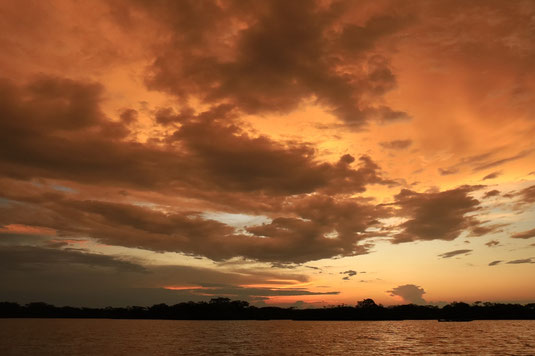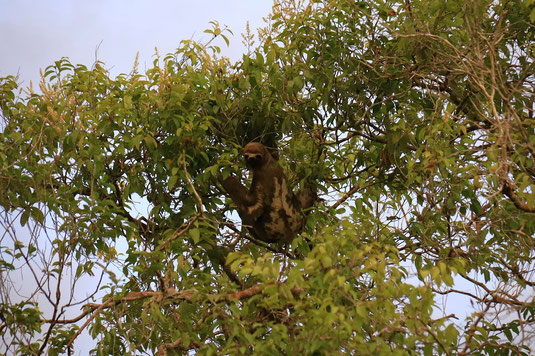5 Days in the Amazon Rainforest:
Adventures in a fragile World.
October 30, 2022

Silently, the canoe glides through the opaque, brown-colored water. To our left and right, liana vines hang from the gnarled trees. It's hot, and the humidity is more in-your-face than the icky chamomile steam bath I had to take when I had fiendish colds in kindergarten.
Even though we're in the middle of the Amazon rainforest and two hours by boat from any road or town, it's noisy. Cicadas chirr like miniature buzz saws, parrots squabble high above our heads in the jungle canopy, monkeys screech in the distance, frogs croak in the lagoons, and a small bird imitates falling water drops.
It is a concert. Without electricity. Without internet or cell phone. In one of the last paradises on earth. Of course, this paradise is highly endangered by the pinnacle of stupidity—humans.
But for now, there are still these places in the Amazon jungle that lead to a world which is colorful, mysterious, and filled with a thousand eyes reflecting light in the night; all demonstrating what an incredible treasure our Earth is.
We are in the Amazon basin for five days during our three-week trip through Ecuador. An experience as intense as the smell of freshly ground coffee. Fiery sunsets, swimming in a lagoon with caimans, night hikes through the jungle, baking bread with indigenous people. No emails, no voicemails, no notifications. Just be. Here and now.
Exploring the Amazon in a canoe

I dig my paddle into the muddy quagmire, covered by several layers of brown leaves and a shallow layer of water. Sweat and sunscreen mix into an unpleasant soup burning my eyes. Damn, didn't I just shower five minutes ago? Why do I again feel like a homeless bum after three nights on skid row?
"One, two threeeee!" our guide Luis commands loudly. Everyone in our group hops into the shallow water at the same time. It's dry season and the river level is dropping almost seven inches every day. Our canoe is stuck. Nothing works anymore. "We gotta get out," Luis sums up.
Our crew disembarks. Wearing knee-high black rubber boots. Fump! I'm standing in watery Amazonian
mud.
"Well, are your boots high enough?" my boyfriend quips as we try to push and lift the canoe through the mid-thigh
mix of water and mud. My clothes stick to me like those statically charged Styrofoam pellets that follow you around the house after you open a package.
"Certainly not," I reply sarcastically. "But did you check to make sure there wasn't a spider in yours first?"
Once our canoe is back in deeper waters, we continue our journey further into the jungle. We see a Broken Branch Bird that just looks the same as a dried-up, broken branch. Then a small monkey with yellow feet. A turtle that immediately plops into the water as I am pulling out my camera. Above all, we hear many things that we cannot see. Although my arms are about to fall off from paddling and I probably smell worse than one of the Hoatzins—also known as stink birds—the tour is a fantastic adventure.
Night hike in the jungle and swimming in the Amazon

During our five days, we take several night hikes through the rainforest. The background noise is even louder in the dark than during the day because many animals are nocturnal.
Luis lights up a spider web. Inside, we see at least fifty spiders. "This is a community," he explains. "Sometimes these webs are 160 feet wide and have up to 20,000 spiders."
Our first, human, reaction is probably, "Ewww!" But once you get off your couch where you watch horror movies about monster crocodiles, poisonous spiders, and killer scorpions, and visit the real animal world, you find that very few of these creatures are dangerous, disgusting, or toxic. We have created a creepy fantasy world of animals living beyond the doors of our homes and cities that has nothing to do with reality. On the contrary. Do you know which creature is the most dangerous in the rainforest? Humans, who hunt, burn, and litter. Just think about that for a moment.

On our way to one of our night hikes, our boat stops in the middle of the big lagoon in front of our small retreat, the fantastic Bamboo Lodge. An eco-lodge built almost entirely out of bamboo. Solar panels provide the little electricity it uses.
Like a batik cloth, the red-purple-orange sky spreads out over the black silhouettes of palm and mangrove trees. Colors as bright as I've ever seen them.
It is swim time!
The water is opaque, the sky almost dark, and there is a pink glitter bouncing on the waves. Caimans are bathing on the sides of the lagoon. But they avoid humans and disappear as soon as they see or hear us. I stretch out my arms and let myself drift in the water, in the blue, post-sunset hour in the Amazon. Magical!
Visiting the Siona tribe - Living in the jungle

Towards the end of our trip, we visit the Siona tribe in Puerto Bolivar. The village is the home of a group of indigenous people. More and more villages are springing up in the middle of the Amazon. "If you went further down the river, you would find entire towns," Luis explains meaningfully.
We walk across wooden planks covering the muddy ground leading from the boat into the community. Just like at our lodge two hours away, there is no internet here, no phone, and only solar power. We meet one of the Sionas, Gladys. She takes us to her garden where yucca plants are growing. From the roots, we will bake bread together today.
"If someone has to go to the hospital, we contact a ranger over the radio. Then a boat comes, and the trip takes twenty minutes," she says as she brandishes a large knife and cuts the yucca plant with powerful, precise slices. I know I do not want to argue with her and then meet her at night later in the jungle.
Our guide Luis translates, because every single tribe has its own language. For us, who are used to having 5000 pharmacies around the corner containing cures for everything, the far away hospital sounds disturbing. But the people out here have an incredible knowledge of the healing power of nature. Plants for inflammation, cramps, poisoning, cuts, fevers...things we've long forgotten because we've gotten too far away from it all. I still wouldn't want to have a heart attack.
Offline – a great experience!

After Gladys digs up the roots, she immediately plants a new shrub using the slices of the yucca that she cut. In a few weeks, she'll have another yucca bush. I can't help but think of all the flimsy PR crap that big companies use to sell their version of sustainability. If the native Amazonian people didn't replace what they use every day, they wouldn't have anything to eat tomorrow. If you take, you must also give, otherwise there's nothing left. Something we desperately need to understand again. So simple, so true, so strikingly apparent at this moment.
From the yucca roots, we make a wet powder, squeeze out most of the water, and then bake the mixture over a fire into a huge circle of bread. No salt, no sugar, and no pepper. And the taste is good, really good!
How often do I miss my mails, Instagram, or WhatsApp while in the jungle? Not at all. It is honestly a relief not to be able or feel the need to see any of it. In the long run, of course, I would miss contact with family and friends, and I would also not be able to do my job as a digital nomad, which would ultimately stop my source of income and funding for such trips.
But when we return to civilization after five days, my need to look at my phone is not great.
Great is what we were allowed to experience while in the Amazon. Great. For the rest of our lives.





